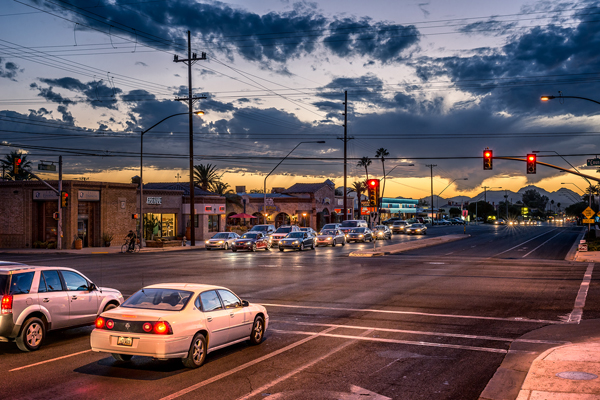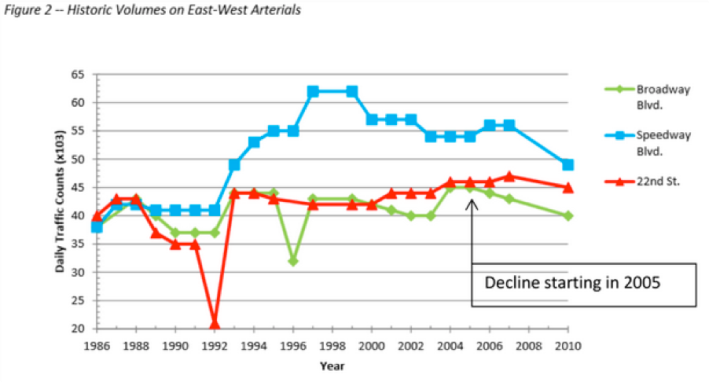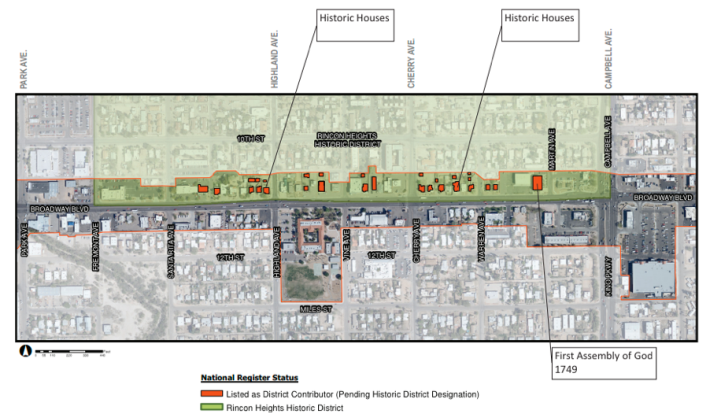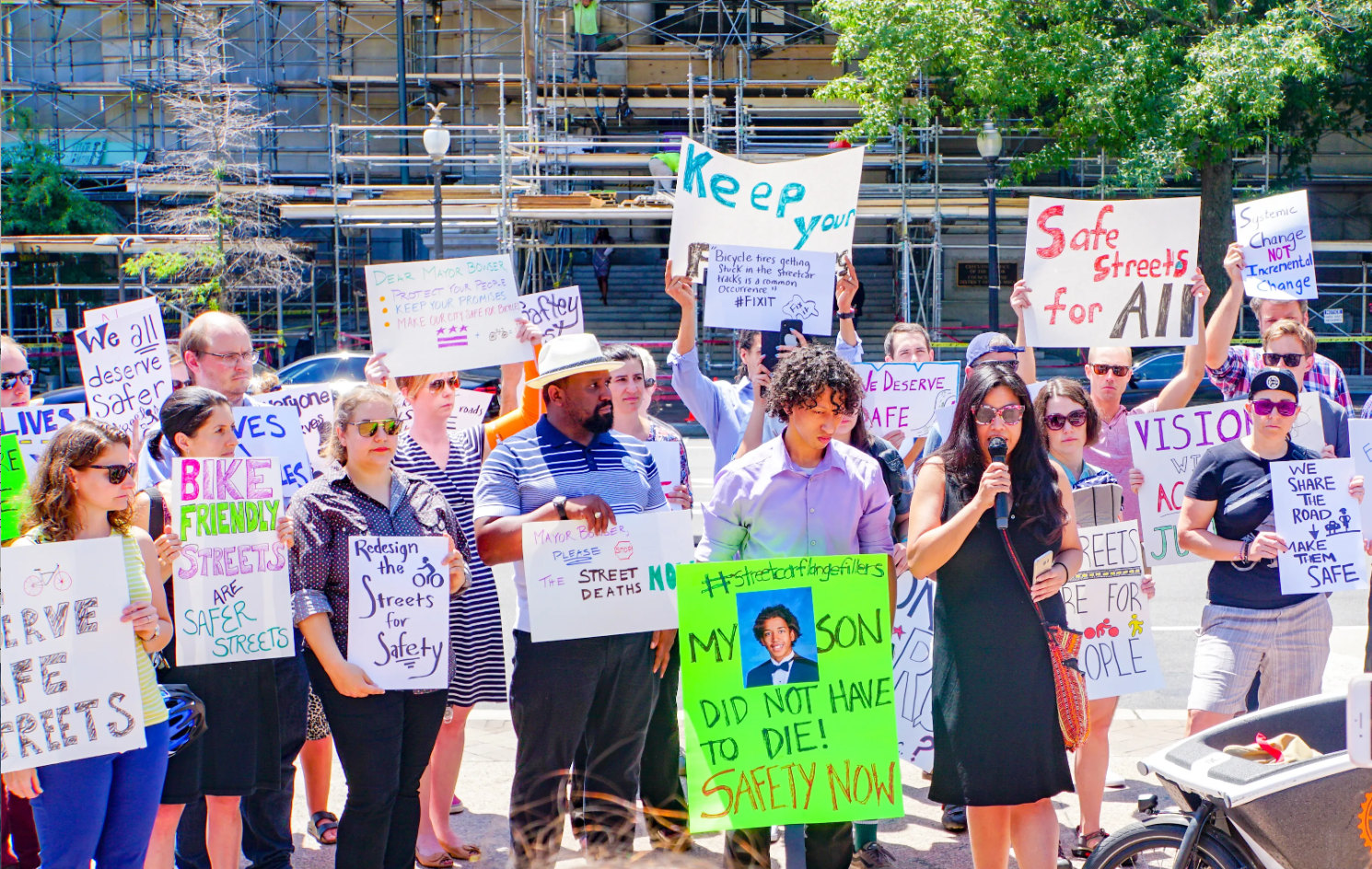
West of downtown Tucson, Arizona, the city runs up against the interstate first and then the mountains, cutting off development. But east of downtown, the city sprawls on for miles. The Sunshine Mile, a shopping and dining corridor centered on Broadway Boulevard, stretches two miles just east of downtown, between Euclid Avenue and Country Club Road.
Pima County and its Regional Transportation Authority are pushing the city to widen Broadway for the length of the Sunshine Mile. And they're threatening to withhold money for bringing the sidewalks into compliance with the Americans for Disabilities Act until Tucson complies.
The long and sordid story begins in the mid-1980s, when engineers predicted that traffic on Broadway would skyrocket from about 35,000 vehicles per day to 56,000 by 2005. To prepare for that veritable onslaught, planners concocted a scheme that involved widening Broadway from less than 100 feet to 150 feet.
The projections never came to pass. Traffic on Broadway has never exceeded 45,000 cars a day, according to Laura Tabili of the Broadway Coalition, which is fighting the road widening. In line with the rest of the country, traffic has actually been declining for the last 10 years. The most recent daily traffic counts on Broadway are now down below 35,000, less than in 1987, and in general the volume is only that high east of the target area.

But the engineering fantasies of the 1980s still made it into a 2006 ballot initiative, in which Pima County residents voted in favor of a half-cent sales tax to pay for the RTA’s 20-year plan. (Pima is the only county in the RTA's jurisdiction.) Project number 17 on that plan was the widening of Broadway Boulevard, in accordance with 1987 projections that had already been proven wrong.
Currently, Broadway has two travel lanes in each direction plus a center turning lane, for a total of five. Some intersections also have right-turn lanes. The 1987 plan would have widened that two-mile stretch of Broadway to eight motor vehicle lanes, including dedicated bus lanes. Wider bike lanes and sidewalks were also part of that plan.
Subsequent models found no advantage whatsoever to the eight-lane design, so most of the conversation now centers on a six-lane option. It’s still up in the air whether that would include two dedicated bus lanes and how wide the bike lanes and sidewalks would be.
One thing that's not in dispute is that the Sunshine Mile needs better sidewalks. Even the Justice Department has warned the city that it needs to bring its sidewalks into ADA compliance. Today, sidewalks are absent altogether in some places and in others are only three or four feet wide, with no wheelchair ramps and too many parking lot curb cuts to meet ADA standards.
Mary Durham Pflibsen chairs the Citizens Task Force, which the City Council charged with settling on and recommending a final design. She says inviting sidewalks and safe bicycle lanes will bring more people into the area, but they have a long way to go to get to “inviting” and “safe.”
"Sometimes there’s a sidewalk but there’s a light pole in the middle of it," said Pflibsen. "It’s not really very navigable for wheelchairs. We have two subsidized housing [developments] that are primarily elderly and disabled residents, and most of them don’t have cars, so you see people with walkers and wheelchairs out there all the time."
“We would like to well exceed ADA compliance,” Pflibsen said.
But the county and the RTA took it too far. The engineers over-designed the road to the extent that bike lanes, sidewalks, and landscaping would together take up 46 feet of the right-of-way, necessitating the teardown of many neighboring properties -- 15 of which appear on the National Register of Historic Places, with 21 more eligible for the list -- while adding a traffic lane. In the end, this six-lane design was wider than the eight-lane option. The budget could top $71 million.
When neighbors balked, the engineers came back with a sidewalk-only option -- that widened the sidewalks to 12 feet and cost $22 million. The ADA minimum width for sidewalks is three feet. Tabili estimates that five-foot sidewalks -- which wouldn't require more land acquisition -- would cost no more than $4 million. Of the $22 million quoted for the engineers' design, $18.5 million is for acquisition and demolition.
"The inflated price of the ADA sidewalks is frightening the city into capitulating to the widening to get the money," Tabili said. "The city of Tucson does not know it, but they probably don't need the county's money to upgrade the sidewalks."
Tabili sees it as "bullying" by Pima County and the RTA. If the city wants to widen the sidewalks but not the road, it will have to pay for it alone -- and pay back $7 million the RTA has already spent for acquisition and design. But throw in some more space for cars and voilà! -- Tucson gets the money from the 2006 RTA ballot initiative, plus some county money thrown in. "In order to get the money from the county that was promised for the road widening, they’re prepared to sacrifice central Tucson neighborhoods," Tabili said.

“I think everyone -- no matter what their vision for the final roadway is -- wants us to be a destination,” Pflibsen said. “We want a strong sense of place, full of thriving local businesses. What hasn’t been decided yet is how can we best do that without threatening historic properties?”
Many properties along the corridor have already fallen into neglect as owners anticipate the road widening project, Tabili said.
There are now several designs floating around, and the Citizens Task Force has been unable to reach consensus.
In October, the 13-member task force did a straw poll, showing a majority in favor of the six-lane design, but with some dissent. Two members would only support it if it included dedicated transit lanes from day one, and one -- Pflibsen -- refused to support six lanes in any configuration since all the designs on the table would widen the right-of-way. Another dissenter vehemently opposed even the consideration of transit lanes.
The task force sent the City Council both the majority report and the dissenting views, letting the Council know they were stuck. Although the task force hadn’t meant for the document to indicate any final decision, and although the Council meeting was reportedly a “study session,” in which votes are not supposed to be taken, the Council ended up voting to approve the expansion to "six lanes including transit," without clearly specifying what that transit might include. There was no vote on any specific alignment, though, so the design is still up in the air. Importantly, the question of dedicating two lanes to transit remains unsettled.
Last week, the task force issued -- by consensus -- a one-page document of recommendations, but they’re still vague and don’t move any closer to a final design. The half-hearted recommendations call for things like “narrow[ing] the roadway where possible to minimize impact” and “manag[ing] acquisitions to minimize costs and derelict properties.”
Plans are expected to be finalized by the city this spring.





